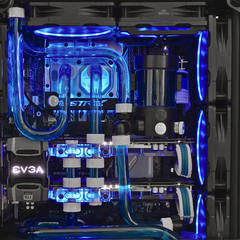
mayhems
Industry Affiliate-
Posts
28 -
Joined
-
Last visited
Awards
This user doesn't have any awards
Recent Profile Visitors
mayhems's Achievements
-
Each coolant has a diffrent electro conductivity, so before each test run a automatic work out of what Current is needed (mA). If you test all coolants across the same current you will get diffrent reading. Also before each test we test direct against the DFU sample that we have and if its not correct or the same with in 2% then its re done until this is achieved to give us the correct base line reading. Then tests are run and the reading taken, A second set are also run to confirm the readings to make sure we get the correct data. All work is done to ASTM D7896-19 Standards and also I have passed my work onto the supplier of the equipment to verify its being done correctly and all has been confirmed and with in the 2% error of correction. Our data is also being passed onto uni's to be verified and VSG is one of them who now works up the road from me. (test equipment is in the PDF's) Equipment used for testing. · Thermtest Measurement Platform MP-2 ATSM and ISO complaint · Thermtest THW-L3 (Transient Hot Wire) · DIUF Water (ASTM TYPE II) 0.589 W/mK @20°C calibration fluid. · Methanol Alcohol 99.95% pure Cleaning fluid If you wish to conduct your own testing and mythology you are welcome to and you can question my results if you wish how ever they are all stated above and will be updated as I work along. All I am doing it creating a database of the information for ppl to use as they wish. It will be updated as we add more information.
-
The numbers are pure unadulterated numbers and there is no way any one can give you perfect numbers when you take into account all factors in play. E.g Pumps, Rads, Flow, Pressure and most of all users ect. These number are relative only to the products tested and are there real true reading. This data set is still being worked on and as you will understand is a slow process and very much unbiased. It doesn't tell everything you need to know as the puzzle is very large. However to you and me its a good data set that has never been done before as just like thermal compound is relative and has a λ (W/mk) rating but once again is just part of a long list e.g adding a cold plate, adding an air cooler or a liquid cooler. Just because a Normal user may not fully understand doesn't make it less relevant. If you read the excel sheets and check the tabs at the base you'll see all the charts and all the data relevant to some of your questions. This is a work in progress project though. But thank-you for your feed back and have updated some info above.
-
We have started with THW (Transient Hot Wire) testing liquid coolants with real data of how thermally conductive liquids are. This is an unbiased way of testing however does not take into account long-term usage or any other issues or in system usage. This is pure analytical, research, development data which is extremely handy for working out information when developing new fluids or looking at what's on the market. There will be no comments on which is best (this is not our aim) nor is it our aim to have a go at coolant makers its simply real data so users can see data that is never published to users and forgoes all the "Claims" they make. There is a lot more work to do and to be added, this is a Work in progress project. This list will grow with time as we test each coolant we can get our hands-on. Tests carried out to ASTM D7896-19 Standards. W/mK stands for Watts per meter-Kelvin. It’s also known as ‘k Value’. The comparison of thermal conductivity can be measured by the ‘k’ value. The k value, or Thermal Conductivity, specifies the rate of heat transfer in any homogeneous material. If a material has a k value of 1, it means a 1m cube of material will transfer heat at a rate of 1 watt for every degree of the temperature difference between opposite faces. The k value is expressed as 1 W/mK. The lower this value is, the less heat the material will transfer. AVG Drift is the result of the drift calculation that was conducted prior to measurement. Delta T Is the total change in temperature over the course of the measurement Test Time is he time in seconds over which the test was conducted Ambient Temperature The temperature of the sensor at the time of the test (in excel sheet) Conductivity The thermal conductivity of the sample (in the excel sheet) Current is The current provided to the sensor during measurement (in excel sheet) I have spoken with the company who we have bought the thermal testing equipment and shown my results and they are extremely close to their own testing and within their 5% tolerance. They have confirmed everything I am doing is correct. -> thermtest if you read the site it will help you understand the results below. There is a 5% tolerance in testing and within a 2% rest tolerance. Any reading that I cannot retest within a 2% tolerance is disregarded and redone until this is achieved. Mayhems - Ultra-Pure H20 Test Date: 24/02/21 AVG W/mk reading : 0.599 λ (W/mk) AVG Drift: 0.2 °C AVG Delta: 2.8 °C Freeze Protection: 0°C Excel raw data file: Mayhems Ultra Pure Excel PDF Report round-up: Mayhems Ultra Pure PDF EKWB - Cyrofuel - Clear Test Date: 25/02/21 AVG W/mk reading : 0.515 λ (W/mk) AVG Drift: 0.5 °C AVG Delta: 7.7 °C Freeze Protection:- 3°C Excel raw data file: Cyrofuel - Clear Excel PDF Report round-up: Cyrofuel - Clear PDF EKWB - Cyrofuel - Solid White Test Date : 25/02/21 AVG W/mk reading : 0.555 λ (W/mk) AVG Drift: 0.3 °C AVG Delta: 0.4 °C Freeze Protection:- 3°C Excel raw data file: Cyrofuel - Solid White Excel PDF Report round-up: Cyrofuel - Solid White PDF ThermalTake - P1000 White Test Date : 25/02/21 AVG W/mk reading : 0.530 λ (W/mk) AVG Drift: 0.3 °C AVG Delta: 2.5 °C Freeze Protection:- 4°C Excel raw data file: P1000 White Excel PDF Report round-up: P1000 White PDF Alphacool - Cape Kelvin Catcher Clear Test Date: 25/02/21 AVG W/mk reading : 0.585 λ (W/mk) AVG Drift: 0.2 °C AVG Delta: 4.2 °C Freeze Protection:- 1°C Excel raw data file: Cape Kelvin Catcher Clear Excel PDF Report round-up: Cape Kelvin Catcher Clear PDF Mayhems - XT-1 Nuke Premixed Clear Test Date: 26/02/21 AVG W/mk reading : 0.502 λ (W/mk) AVG Drift: 0.3 °C AVG Delta: 2.5 °C Freeze Protection: -12°C Excel raw data file: Download PDF Report round-up: Download Mayhems - X1 Premixed Clear Test Date: 26/02/21 AVG W/mk reading : 0.504 λ (W/mk) AVG Drift: 0.2 °C AVG Delta: 3.1 °C Freeze Protection: -8°C Excel raw data file: Download PDF Report round-up: Download Mayhems - Ultra-Pure H20 / Mayhems Biocide+ / Mayhems Inhibitor+ Test Date: 26/02/21 AVG W/mk reading : ? λ (W/mk) AVG Drift: ? °C AVG Delta: ? °C Freeze Protection: 0°C Excel raw data file: ? PDF Report round-up: ? --== More tests to come and be added to the list ==-- More will be added as we test more. This will take time. We are also looking for ppl to send us samples of coolants we only need 50ml all testing is free of charge. We are aiming to start with just clear and white coolants and will look at colors are a different date and we may also start going into alternative coolants. Finally, all this data is mine and mine alone, if you wish to use this data in any future work please reference Mayhems (me) as the protagonist. Basically, you can use my data any way you wish but make sure you say where you got it from. Updates: 26/02/21 Added real freeze protection data (not taken from websites of the makers of coolants) actual testing in-house to find real freeze points. This is important as it helps to understand more why a coolant's λ (W/mk) may be lower. E.g The benefit of freeze protection may be more important than the heat load capacity of the fluid.
-
The Best Documented PC Coolants
mayhems replied to For Science!'s topic in Custom Loop and Exotic Cooling
Not some thing we would do or suggest TBH. In the loop its has pressure as well as heat and it being forced though fins, this all helps. Boiling or cooking it is not the way forwards. As said it some thing were going to look into and see if there is some thing we can add to stop this from happening. -
The Best Documented PC Coolants
mayhems replied to For Science!'s topic in Custom Loop and Exotic Cooling
Oky initial testing. Freezing XTR in its current form is not a good idea, Initial testing has shown that when freezing and un freezing the coolant there is double the amount of drop out. The charge around the larger particles is lost, how ever warming back up in a system and running a full heat load (low rpm fans and bench mark suite to create the heat) causes the particles to create the charge again. This is early testing. We will look into this further when we made this coolant we didn't look into freezing it as it was not one of our goals but some thing we will investigate further. -
The Best Documented PC Coolants
mayhems replied to For Science!'s topic in Custom Loop and Exotic Cooling
This is a very good question and one i did not think about, Please leave this with me and ill get back to you on that one as soon as i can, we will need to test this. -
The Best Documented PC Coolants
mayhems replied to For Science!'s topic in Custom Loop and Exotic Cooling
1) Mayhems Sub Nano XTR is a strict Dev project only, XTR Premixed Nano coolant is a public product and is on sale now. 2) Will XTR settle? short answer yes, it is impossible defeat gravity, all fluids settle in one form or another due to different density and the gravimetric effect. Another answer is some of it will settle with time and no flow in a system. It is picked back up straight away (within minutes) when the flow is going inside the loop. We have tested this a lot. This is the nature of the beast. 3) Reputation! we can take into account our old fluid Mayhems pastel, when it was manufactured sold over 100 tones + in the 10 years and what you read on the net is tiny to the amount we sold, Our issue rate was calculated at 0.0001%. We did have issues with our supply chain and them basically dropping there quality of supplied martials to us, this is when we stopped making Pastel. Other fluids manufacturers are not our problem and we do not get involved with them. Our only concern is our product and our customers. 4) XTR is Sub 6nm it will go through micron filters. Filters should not be used in a closed loop liquid cooled pc, that is a bad idea. You are restricting flow paths and creating a bottle neck. In 35 years of liquid cooling, we have never needed to use one. 5) XTR is not compatible with any other fluids, it is not based on the same principles as other glycol-based coolants. We will not be testing compatibility. Any formulations we are currently working on are not for Sub Zero Cooling. Our aim is to bring to the forefront Nano technology to the liquid cooling world not to rehash old methods. We may look later down the line at sub zero cooling but using different methods. 6) Shipping 100% out of our control. Blame greedy companies, reduced shipping fright ect ect the list goes on. There are plenty of Youtubers who have explained what is going on in the world. 7) In testing it has shown to be non- abrasive at the micron level after 6 months of constant running fluids passing over a nickel-plated blocks (EKWB, Alphacool and Heatkiller tested). Some testing was done externally of Mayhems via a non bias company. I think some one needs to make a new thread if you are interested in XTR and I will follow it. This thread is about documenting SDS sheets for coolants. Sorry I feel as though we should not do this and is disrespectful to the original poster. -
The Best Documented PC Coolants
mayhems replied to For Science!'s topic in Custom Loop and Exotic Cooling
Any time, just give me a shout i don't mind sending out samples to ppl who are really interested. As far as i'm concerned its people like your self i like to hand samples over to not only for feed back but also to share the knowledge. You show a good knowledge and understanding of what we are up to and this is brilliant in my eyes. -
The Best Documented PC Coolants
mayhems replied to For Science!'s topic in Custom Loop and Exotic Cooling
We are hoping for good photos just for advertising and simply to see what it looks like (out of pure interest). Also good for documenting. You have shown such a keen interest, if you would like a 1 ltr of this fluid to look over and give us your feed back I am willing to ship some over to you free of charge. -
The Best Documented PC Coolants
mayhems replied to For Science!'s topic in Custom Loop and Exotic Cooling
We expect minimum between 5 to 10 years. How ever that is at best guess. Sorry seem to be taking over this thread. ill create a new one with all the info later on if I'm allowed. -
The Best Documented PC Coolants
mayhems replied to For Science!'s topic in Custom Loop and Exotic Cooling
Yes, mayhems pastel is EOL, XTR is an Opaque looking fluid but we are not calling it "pastel". Its a Nano fluid and being advertised as such. We also have a Sub 1nm Nano fluid and that is clear and also works better at stopping light how ever this is not being produced for consumers its for indusial usage and is still in dev phase. Ref you question on the photos at a nano level, i have spoken this morning to a company and we are getting access to a newer electron microscope, The TEM we used is not good enough to get down to 20nm as the backing plate is graphene based and the Zn0 isn't giving a good enough picture. Hopefully in the next few weeks once we have access to the newer Electron Microscope we can provide better photos. -
The Best Documented PC Coolants
mayhems replied to For Science!'s topic in Custom Loop and Exotic Cooling
You can what ever you like. Then old koolance loops were interesting. I still remember ripping out Bike rads to cool my 3dfx lol. -
Water cooling parts life span?
mayhems replied to EmoChipmonk's topic in Custom Loop and Exotic Cooling
We have rads now over 20 years old, D5's last for about 8 to 9 years max DDC 2 to 3 years there no ware near as good as D5's, cheaper brands you'll get about 3 years, Copper or plated blocks can last for ever (just replace o-ring now and then), Fittings last for ever just replace o-rings. A good water cooling kit will out last you PC if you maintain it. Cheap kits last a couple of years. -
The Best Documented PC Coolants
mayhems replied to For Science!'s topic in Custom Loop and Exotic Cooling
Long story short - we no longer make pastel and its been removed from sale due to QC issues with our old supplier. (all pastel lines) -
How do I clean this? And what do you call this?
mayhems replied to ImNotNeko's topic in Custom Loop and Exotic Cooling
yw.





